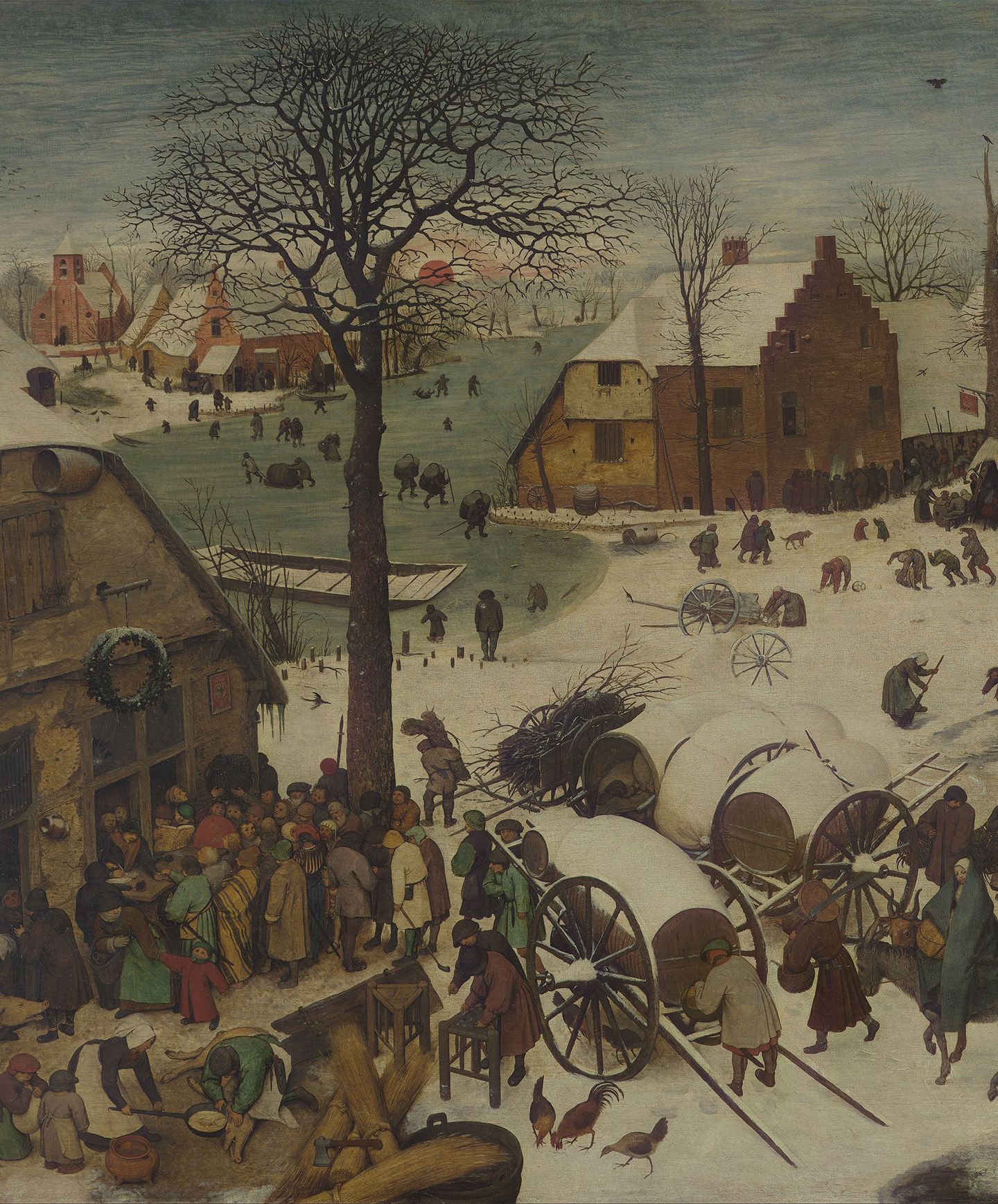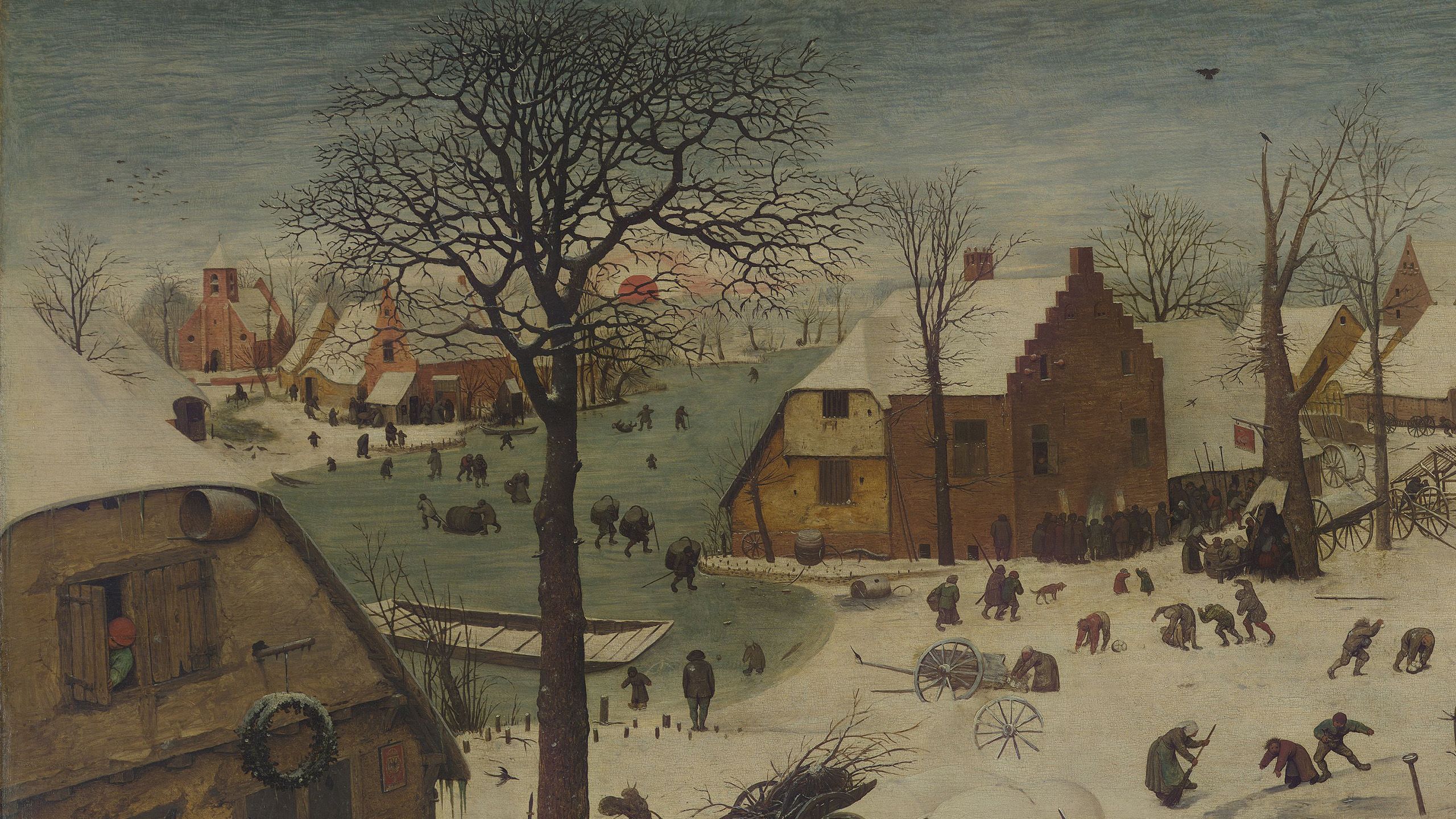The Census at Bethlehem
Pieter Bruegel the Elder

If someone were given a classroom activity of matching paintings to their titles, they would be forgiven for getting this one wrong. Indeed, the artist himself might well take issue with the “correct” answer, seeing that many titles of paintings are later decisions, a necessity of cataloguing, procurement and museum management. Titles in use today were not necessarily given by the artist, patron or early owners.
At some point a decision was made to call this 1566 painting by Pieter Bruegel the Elder The Census at Bethlehem, in Flemish: Volkstelling te Bethlehem.
Yet we cannot be looking at Bethlehem. This harsh winter, with rivers frozen thick enough to traverse, is northern European. And the villagers we see are not in Roman Judea, they are in the Low Countries in the 16th century as the architecture, such as the stepped gable, and the dress of the inhabitants so clearly tell us. In this painting Bruegel has depicted the world he saw from his window, not that of a biblical past.
Yet it is Bethlehem. It is Bethlehem because a carpenter has arrived, with his wife riding on a donkey behind him. They have travelled to this village at the behest of the local authorities, and they will seek shelter where they can. Bruegel, like many Renaissance artists, has used anachronism to present a biblical story in a contemporary setting.
The arrival of Mary and Joseph gives a very specific time to this snowy landscape. It is not just winter, it is very close to Christmas. Other elements of the scene support this - the villagers are busy, even busier than usual as they prepare for the upcoming festival while the day is still light.
While the adults toil, several children play. Their snowball fights and games on the ice introduce a sense of joviality and indicate that this village is on the cusp of a celebration.
In the lower left corner a pig is butchered, an activity which agricultural calendars from the mediaeval period associated with December.
As Mary and Joseph arrive in this “Bethlehem”, anticipating the arrival of their child, they are surrounded by villagers from an entirely different time and place, themselves making preparations for Christmas according to their own traditions. In this way the painting evokes a dizzying sense of time travel. But Mary and Joseph do not appear as visitors from another time, indeed Bruegel is careful to embed them seamlessly within the scene. They do not stand out or appear different from the rest of the people in the painting. Joseph especially, turned away from the viewer, leaning forward as he presses through the snow, the weight of his crosscut saw bearing down on his shoulder, is hard to differentiate from several other figures who bend beneath their loads, or toil in the snowy scene. Mary is afforded slightly more prominence, albeit subtly. She is one of the few figures in the painting whose face is visible and she is also the only person in the crowded scene who is not on foot.
Unnoticed by the locals, they head towards a public house. The barrel mounted beneath the eaves, and the pewter jug on the side of the building make clear that this is an inn of sorts, and by the look of the crowd, there will not be room there tonight.
While in the nativity story (at least according to the Gospel of Luke) Mary and Joseph travel to Bethlehem for a census, Bruegel’s scene most likely depicts tax collection. High on the wall of the inn on the far right, is a temporary red sign featuring the Habsburg coat of arms.
Although swathes of the Low Countries had been ruled by the Habsburgs since the 1480s, in 1556 (a decade before this painting was made) control was passed to the Spanish branch of the family. These arrangements were made shortly before the death of Charles V, Holy Roman Emperor and Archduke of Austria, whose dominion was split between his son, Philipp II of Spain, and his brother, Ferdinand I. The Habsburg territories in the Low Countries now became the “Spanish Netherlands”, under the rule of Philip II, who was at this time still married to Mary I of England, although it would not be long before her death.
Bruegels and his fellow countrymen felt several consequences of falling under the rulership of Philip II of Spain, and one of them was heavy taxation. Another was Philip’s fervent defence of the Catholic faith and persecution of dissenters. This was felt keenly in the Low Countries, where the Protestant Reformation had found fertile ground and there were large communities of Lutherans, Anabaptists and Calvinists. While the whole of Pieter Bruegel’s life had coincided with the shifts brought about the Reformation in Europe, The Census at Bethlehem was painted during a particularly turbulent time, and not long before tensions between the Spanish crown and its subjects in the Low Countries would would descend into the 80 years war. With this in mind, one wonders about the fate awaiting the villagers we see in the scene.

If Mary and Joseph arriving in Bethlehem represent a world on the eve of Christianity, the peasants in Bruegel’s picture represent a world steeped in it. Their calendar is dictated by it, their hopes are pinned on it (note the leper’s hut with a crucifix above the gable), and their lives are at the mercy of those fighting over its interpretation and practice.
The fact that the villagers are constantly at the mercy of forces beyond their control might, literally, be at the heart of this painting. At the geometrical centre, found at the intersection of the diagonals, we find a single wheel. It is one of several cartwheels in the scene, and must belong to the one-wheeled wagon stuck in the snow behind it. While it may not immediately draw attention, its isolation and central position do lend it significance. One interpretation is that this is the wheel of fortune, a reminder that circumstances change, and that the earthly lives of the masses are subject to forces often beyond their control. Remembering that we are in “Bethlehem” with the birth of Christ imminent, this wheel is about to make a very significant turn.
While we might try to assert earthly control with rules, taxation, lists and censuses, such actions only get us so far. The task of counting and accounting for the teeming and populous village will be a difficult one, and from a divine perspective, is surely inconsequential.
And this is the perspective which the viewer is given. We look at the scene from a distance, and from above, as if we are looking down at earth from the heavens. We are encouraged to see the community as a whole, its inhabitants blending anonymously into a crowd. We see the relentlessness and hardship of their lives: they work, they struggle, they huddle against the cold. There is little respite, but there is hope. The village has derelict buildings, but it also has newer ones. There are epidemics and illnesses, but there are also healthy children who play energetically. Bruegel presents Christianity as a source of this hope. As well as the Holy Family, the church in the left hand corner has a quiet but weighty presence in the picture. The pink-ish tone of its walls, and the other buildings surrounding it appear warmer and brighter than the buildings in the foreground. Although it is placed at the extremity of the settlement, our eye is drawn to it by the line of people crossing the river who create a direct thread between it and the rest of the scene. Earlier I stated that Mary is the only figure in the scene who is not on foot, but a close inspection of the path in front of the church reveals one other exception. Small, but clearly recognisable nonetheless, is a lone figure on a donkey, riding away from the church through the icy slush which covers the way.
One immediately thinks of Jesus’ entry into Jerusalem on Palm Sunday, and indeed this could be a foreshadowing of the Easter story. It was not unheard of for nativity paintings to anachronistically reference the crucifixion as a nod to the fate of the newborn child; an earlier Netherlandish painter, Rogier van der Weyden, had done this in 1455 on the Saint Columba Altarpiece.

While Bruegel’s exact political or religious affiliations are the subject of conjecture, there are some hints that this painting is the work of a pro-Reformation thinker. One of the few overt signs of Christianity amongst the villagers is the crucifix on the gable of the leper’s dwelling. Its presence draws a clear link between holiness and lowliness. As its inhabitant cannot partake in congregational worship, his hut has become a church in its own right and the leper a member of the “priesthood of believers”, the Reformation principle that believers had direct access to God and need not rely on the clergy or church institutions.
Bruegel left hardly any records of his own life, but the large collection of paintings and etchings he created allow us to see the lives of his contemporaries in sharp focus, revealing not only the activities which saw one day give way to the next, but also the broader social circumstances of an age in which seismic changes were afoot.



